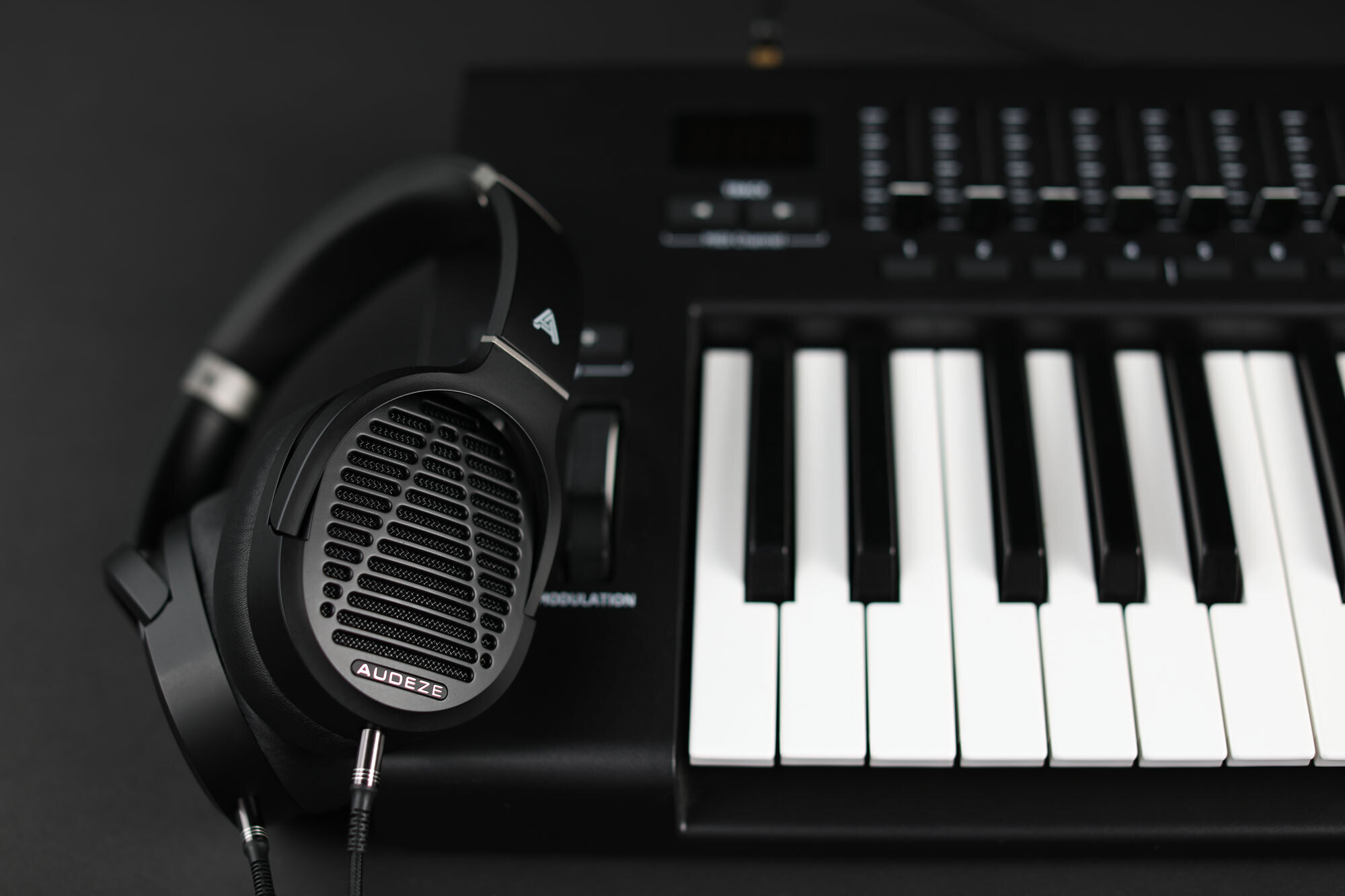Audeze is one of the only headphone makers devoted exclusively to using planar-magnetic (PM) drivers in its products. The company offers a wide range of models, from reference over-ear designs to gaming-specific cans to in-ear monitors, all of which are based on PM technology.
I have little experience with planar-magnetic headphones. Many years ago, I reviewed the Stax SR-007 MK2 electrostatic headphones, which use a somewhat similar technology, but they require a special amplifier and are extremely expensive. But I’ve never spent any quality time with PM headphones. So, when I got the opportunity to review the Audeze LCD-1, I jumped at the chance—and now that I’ve given them a good listen, I’m very glad I did.
Planar-magnetic technology
Most headphones use dynamic drivers to generate sound waves. In these drivers, an electrical audio signal is sent through a coil of wire—the voice coil—which creates a magnetic field around the coil that oscillates according to the waveform in the signal. The oscillating magnetic field interacts with the static field of a permanent magnet mounted nearby, which pushes and pulls on the voice coil, causing it to vibrate in response. The voice coil is attached to a diaphragm, which vibrates along with it, sending sound waves into the listener’s ear.

Planar-magnetic drivers are similar in principle but different in implementation. Instead of a voice coil, the diaphragm in a PM driver is directly embedded with a flat conductor that snakes back and forth across its entire surface (see Fig. 1). That conductor carries the audio signal, and the oscillating magnetic field interacts with the static field of permanent magnets mounted very close to the diaphragm. That causes the diaphragm to vibrate according to the audio signal, generating sound waves that enter the listener’s ear.

In this “exploded” rendering of an Audeze earcup, you can see the circuit-trace pattern (aka, “voice coil”) on the diaphragm. You can also see the magnet and Fazor structures, which are discussed in the next section.
The main difference is that a PM driver has no separate voice coil per se; the “voice coil” and diaphragm are a single component. As a result, the entire diaphragm vibrates more uniformly than a dynamic diaphragm, which is pushed and pulled at its center by the voice coil.
Also, the magnets in a PM driver are generally larger than those used in dynamic drivers, because they must be roughly the same size as the diaphragm. That makes planar-magnetic headphones generally larger and heavier than dynamic designs.
So, what are the advantages of PM headphones over dynamic cans? Generally speaking, planar-magnetic headphones tend to have tighter, more accurate bass response. And because the entire diaphragm moves uniformly, the planar soundwave creates a better soundstage with a more immersive quality, and there tends to be less distortion at high levels. For these reasons, PM headphones are often preferred by critical listeners such as recording engineers and audiophiles.

Audeze LCD-1 features
The LCD-1 is an open-back, circumaural (over-ear) headphone. It’s more compact than many PM headphones and weighs just 8.8 ounces. It sports memory-foam earpads and headband covered in lambskin leather and comes with a nice carrying case into which the headphones fold. The included premium braided cable terminates with a 3.5mm connector, and a 1/4-inch adapter is included.
Interestingly, the plugs for each earcup are TRS (tip-ring-sleeve), which I thought might mean that the drivers are wired for balanced operation. But I was informed that they are not balanced; instead, the three-conductor connectors are used to automatically determine which signal is left and right, so it doesn’t matter which one is connected to each earcup. Clever!

With an impedance of 16 ohms, sensitivity of 99 dB/mW (calculated at the eardrum), and a power-handling capacity of 5W RMS, the maximum sound output is rated over 120dB SPL with THD less than 0.1% at 100dB SPL. The frequency response is specified from 10Hz to 50kHz (no tolerance given).
Audeze designs and builds its headphones in the United States and touts several enhancements it has made to planar-magnetic technology. One of them is its ultra-thin Uniforce diaphragms, which are very lightweight, presenting very little resistance to movement for improved transient response. And its large size of 90mm in diameter facilitates deep bass reproduction.
The company makes all its drivers in its Southern California facility, using a vacuum-deposition process to coat the diaphragm film with conductive metal that is then etched to form the “voice coil” on the surface. To achieve a uniform magnetic force across the entire surface area of the diaphragm, Audeze actually varies the width of the voice-coil tracing depending on the strength of the magnetic field at different locations.

According to the company’s website, “Audeze uses ‘a genetic algorithm-based heuristic optimization technique together with magnetic simulations to optimize trace widths to achieve Uniforce.’ For those of us who don’t speak Martian: we use advanced computing techniques to get the most uniform distribution of force possible on the diaphragm.”
Another Audeze innovation is its Fluxor magnets. The description on the company’s website gets pretty technical, which I won’t go into here; if you want to dig deeper, click here. Suffice to say that Fluxor neodymium magnets increase the magnetic field strength at the diaphragm without adding more weight to the assembly.
In the company’s flagship headphones, each diaphragm is suspended between two Fluxor magnet structures, as seen in Fig. 1. But in the LCD-1, there is only one magnet in each earcup, located between the ear and the diaphragm. This is less efficient than a double-sided design, requiring more amp power, but it allows the headphones to be lighter. And the Fluxor magnet is more efficient than a conventional magnet, focusing more of the magnetic field toward the diaphragm.
Why place the magnet between the ear and diaphragm rather than the other way around? Two reasons—to protect the diaphragm and to allow damping material to be placed on the other side.
In most planar-magnetic headphones, including those from Audeze, the magnet is a slotted structure that allows sound to pass through the slots. As you might recall from basic physics, when waves pass through parallel slots, they cause interference patterns (see Fig. 2), which can degrade the sound quality. Audeze solves this problem with its Fazor waveguide attached to the magnet structure. According to the company, this eliminates the interference patterns, corrects the phase response, and improves the acoustic impedance.

Without the Fazor waveguides, sound waves emerge from the slots and interfere with each other, degrading the sound quality. The Fazor waveguides eliminate this interference. In this diagram, there are magnets and Fazors on both sides of the diaphragm, but in the LCD-1, they are only on one side.
Performance
The LCD-1 is quite lightweight, and the earpads are very comfortable; my ears fit nicely in them, and they are super-soft. The earcups provide a surprising sense of isolation, despite being their open-back design. My only complaint here is that the headphone feels a bit flimsy.
As usual, I played high-res audio files from the Tidal Master library on my iPhone XS, using the iFi hip-dac (reviewed here) as the DAC/amplifier. First up was “In Too Deep” by Jacob Collier from his most recent album Djesse Vol. 3. The vocals are accompanied mostly by synths with some super-low bass, all of which was rendered beautifully by the LCD-1—clean and clear with an open soundstage and natural, present vocals. The deep bass was exceptionally well represented without bloat or congestion, and it balanced the rest of the spectrum perfectly.
I haven’t seen Pixar’s latest movie Soul yet, but the soundtrack album is now streaming from the Tidal Master library. I listened to “Collard Greens and Cornbread Strut,” a very short but hard-bopping piece played by a jazz combo of piano, bass, drums, and horns, including a smokin’ tuba. It sounded clean and open on the LCD-1; I could hear each instrument clearly within a unified whole.
This year, composer Max Richter wrote and recorded a haunting musical backdrop entitled All Human Beings meant to accompany the reading of the United Nation’s Universal Declaration of Human Rights. On his album Voices, the piece begins with Eleanor Roosevelt reading the Preamble in a 1949 recording, after which many other modern voices continue reading the Declaration in a wide variety of languages. It’s a lovely tribute to basic human rights that are all too often ignored in today’s world.
In addition to Voices, Richter also released a related album called All Human Beings, which includes a six-minute version of the piece played five times. Each one starts with the Eleanor Roosevelt recording that morphs into a modern voice reading Article 1 in one of five different languages—English, Spanish, German, French, and Dutch. (I wish he had included some languages from places other than western Europe.) I listened to the English version on the LCD-1, which sounded gorgeous, with a wide soundstage for the orchestra and choir, and the voiceover sounded completely natural and present.

Next up was “Starlight” by guitar legend Lee Ritenour from his album Dreamcatcher. Most of the album is simple solo guitar—in this case, an acoustic guitar tuned quite a bit lower than normal. The folky, fingerpicked piece sounded clean, open, and well-balanced on the LCD-1, with a wonderful low end and no hint of congestion.
For some throwback fun, I listened to “Money For Nothing” from Dire Straits’ 1985 album Brothers in Arms, which was just released in MQA format. The LCD-1 presented a big, open soundstage in which the stereo drums really bounced around. Once again, the sound was clean, and I could hear each instrument and voice clearly, including Sting’s unmistakable guest vocals.
Lately, I’ve been listening to a lot of The Manhattan Transfer, one of my favorite vocal groups, so I cued up “Cantaloop (Flip Out!)” from The Junction. The music is based on the classic Herbie Hancock tune “Cantaloupe Island” with lyrics by Us3. It’s a richly produced track and a wonderful mix with deep bass and an infectious groove. As I had come to expect, the LCD-1 did it full justice with a clean, open sound. The deep bass was perfectly balanced with the rest of the ensemble without becoming overbearing.
I always include some classical music in my review listening. This time, I started with the first movement of Tchaikovsky’s Serenade for String Orchestra in C Major, Op. 48, from the album Serenades by the Zürcher Kammerorchester under the direction of Daniel Hope. Once again, the sound of the LCD-1 was clean, open, and well-balanced. The strings sounded vibrant, and I could clearly delineate each section within a cohesive whole.
Finally, I listened to the fourth movement of Beethoven’s Symphony No. 7 in A major, Op. 92, as recorded by the Rotterdam Philharmonic Orchestra under the direction of Lahav Shani. The LCD-1 had a nice, open, wide sound with excellent balance.

In addition to the LCD-1, I listened to the same tracks on the Cleer Flow II ($199.99, reviewed here and DALI IO-6 ($499, reviewed here). These dynamic headphones are in roughly the same price ballpark as the LCD-1—the Flow II is $200 less, while the IO-6 is $100 more—and I gave both of them very high marks in my reviews. In this comparison, I used them in passive mode—that is, I did not turn their power on, and I connected them to the iFi hip-dac with their included audio cable.
In all cases, the Flow II and IO-6 had slightly more pronounced bass than the LCD-1, and the IO-6 was a bit louder at the same volume setting. In fact, the bass was sometimes a bit overbalanced, especially on the Flow II, which also exhibited a hint of congestion in the low end on some tracks. And on “Collard Greens and Cornbread Strut,” the Flow II sounded slightly veiled. Also, the IO-6 had a slightly warmer, creamier sound overall.
Keep in mind that these differences were generally small and mostly evident only in a direct and immediate comparison. Overall, both headphones still sound excellent, especially if you prefer a slightly bass-forward presentation. On the other hand, the Flow II was the least comfortable to wear—the earpads are too small for my ears, and the clamping pressure on my head was too high.
Just for grins, I also pulled out the Focal Stellia ($2,999, reviewed here). Granted, it costs more than seven times as much as the LCD-1, so it’s not really a fair comparison. But it’s the best headphone I have on hand, so what the heck? As expected, the Stellia had the best sound of all the headphones I listened to for this review—gorgeously rich and detailed with the most presence and detail as well as superior dynamic range. It did have a touch more bass than the LCD-1, but not as much more as the Flow II and IO-6.

Bottom line
As I was listening to the LCD-1, the words that kept coming to mind were “transparent” and “precise.” The sound was very open, allowing me to listen deep into the mix. And the balance between frequency ranges was exceptionally flat, with just the right amount of bass—extending well into the subterranean depths—that never overpowered the mids or highs.
Clearly, the LCD-1 does not follow the “smiley” EQ curve that boosts the bass and treble in many consumer headphones for the sake of impact and razzle-dazzle. Some might complain about deficient bass, but I found the sound to be refreshingly neutral. In fact, I would characterize the LCD-1 as highly revealing, even unforgiving, which is just what recording engineers and many audiophiles want in a headphone.
Also, transients were never smeared, and the soundstage was nice and wide. The latter observation is probably due in no small part to the open-back design, which also offers less isolation from environmental sounds. But in my quiet room, I was surprised at the sense of isolation I felt when I put on the LCD-1.
I have only a couple of minor quibbles. The LCD-1 is very lightweight, which is great, but that comes at the expense of feeling a bit flimsy. On the sound-quality front, I was never impressed with the dynamic range. It wasn’t bad, just not quite as wide as I’ve heard from other headphones.
With a list price of $399, the Audeze LCD-1 is far less expensive than most planar-magnetic headphones. Along with its generally outstanding sound quality, that makes it a no-brainer in my book.
The Audeze LCD-1 has a wonderfully open, clear, neutral sound, and it costs far less than most planar-magnetic headphones.
Pros
- Open, clean, transparent, precise sound
- Completely neutral tonal balance
- Wide soundstage
- Less expensive than most PM headphones
Cons
- Slightly flimsy feel
- Dynamic range a bit narrow
Source: techhive.com




































